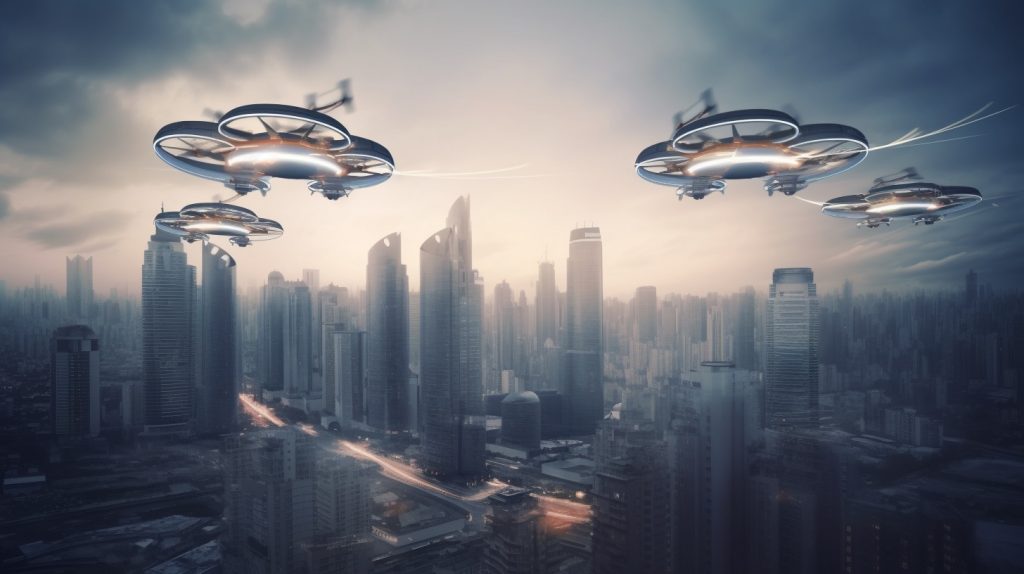Drones with Obstacle Avoidance rapidly progress, especially in the realm of safety features. Obstacle avoidance technology has become a pivotal component to ensure smooth and secure flights, minimize the risk of accidents and damages, and empower pilots to execute more intricate maneuvers effortlessly.
As drone technology becomes increasingly commonplace and competition among manufacturers intensifies, drones equipped with obstacle-avoidance capabilities are becoming more affordable. This blog post aims to acquaint readers with the top drones featuring obstacle-avoidance capabilities that are currently available on the market.
What are unmanned drones with obstacle avoidance?
In recent years, the use of drones has been increasingly popular, leading to a demand for reliable collision detection and prevention technologies. Drones are often deployed in environments where there is a risk of collision with various objects such as buildings, trees, and other aircraft. To ensure the safety of both the drone and its surroundings, having a dependable collision detection and prevention system is crucial.
There are several different types of collision detection and prevention technologies available for drone flights. The most common type is radar-based collision detection, which employs radio waves to detect objects in the drone’s path. This type of system is typically used in larger drones, such as those used for commercial purposes.
Another type of collision detection and prevention technology is optical detection. This system uses cameras to identify objects in the drone’s path. This type of system is typically employed in smaller drones, such as those used for recreational purposes.
Finally, collision detection and prevention technology based on GPS is also utilized. This system leverages GPS signals to detect objects in the drone’s path. This type of system is commonly employed in larger drones, such as those used for commercial purposes.
Regardless of the type of collision detection and prevention technology used, ensuring system reliability and accuracy is crucial. This will help ensure the safety of both the drone and its surroundings. It is also important to ensure that the system undergoes regular testing and maintenance to guarantee proper functioning.
Overall, there are several different types of collision detection and prevention technologies available for drone flights. Each type has its own advantages and disadvantages, so it is important to consider the drone’s specific needs before selecting a system. This approach can ensure the safety of both the drone and its surroundings.

How to Implement Collision Detection and Prevention Systems for Drone Flights
In recent years, the use of drones for commercial and recreational purposes has sharply increased. As the number of drones in the sky grows, there is a rising demand for effective collision detection and prevention systems. To ensure the safety of both drone operators and those on the ground, it is crucial that these systems are implemented correctly.
Collision detection and prevention systems are designed to identify and prevent potential collisions between drones and other objects in the sky. These systems utilize a combination of sensors such as radar, lidar, and cameras to detect objects in the drone’s path. Once an object is detected, the system takes action to avoid a collision. This may involve altering the drone’s course, slowing down, or even coming to a complete stop.
The first step in implementing a collision detection and prevention system is selecting the right sensors for the task. Different sensors possess distinct capabilities and limitations, thus it’s vital to choose those best suited for the given purpose. For instance, radar excels at detecting larger objects, while lidar is more adept at spotting smaller ones.
Once the sensors are chosen, the next step is their installation on the drone. This can be achieved by attaching the sensors to the drone’s body or utilizing a separate mounting system. Ensuring secure attachment and avoiding interference with other components is crucial.
The final step involves programming the sensors for detecting and preventing potential collisions. This can be accomplished using various software packages such as Autopilot or Pixhawk. These programs enable users to set sensor parameters like range and sensitivity, as well as configure the drone’s response to detected objects.
By following these steps, drone operators can ensure that their drones are equipped with the necessary collision detection and prevention systems. This will help safeguard both drone operators and individuals on the ground from potential collisions.
Advantages of Using Collision Detection and Prevention Systems for Drone Flights
The use of collision detection and avoidance systems for drone flights is becoming increasingly popular as technology advances. These systems are designed to detect and navigate obstacles in the drone’s flight path, ensuring a safer and more efficient flight.
The primary advantage of using collision detection and avoidance systems for drone flights is the enhancement of safety. By detecting and maneuvering around obstacles in the drone’s path, the risk of accidents is significantly reduced. This is particularly crucial for drones used for commercial or industrial purposes, as accidents could lead to costly damages or injuries.
Another advantage of using collision detection and avoidance systems is the improvement of efficiency. By avoiding obstacles, drones can fly faster and more efficiently, reducing the time required to complete a task. This is especially beneficial for drones used for delivery or surveillance, as it enables them to perform their tasks more quickly.
Finally, the use of collision detection and avoidance systems can also help reduce the risk of property damage. By avoiding obstacles, drones can navigate around buildings and other structures, decreasing the risk of property damage. This is especially crucial for drones used in urban environments, as an accident could lead to costly repairs.
Overall, the use of collision detection and avoidance systems for drone flights offers numerous advantages, including increased safety, efficiency, and reduced risk of property damage. As technology continues to advance, these systems will become increasingly vital for ensuring the safe and efficient flight of drones.
Firstly, the sensors used for obstacle detection must be accurate and reliable. These sensors should be able to detect obstacles in various conditions, including low lighting, fog, and rain. Additionally, the sensors should be capable of detecting obstacles at a distance as well as in close proximity.
Secondly, the algorithms used to process data from the sensors must be able to accurately identify potential obstacles and determine the best way to avoid them. This requires complex calculations and decision-making processes that need to adapt to changing conditions.
Thirdly, the drone must be able to quickly and precisely respond to the data from the sensors and algorithms. This demands a high degree of maneuverability and agility, as well as a reliable communication system between the drone and its controller.
Lastly, the system must be capable of functioning in various conditions, including urban, rural, and remote areas. This requires a reliable system that can handle a wide range of conditions and obstacles.
The challenges of implementing collision detection and avoidance systems for drone flights are significant, but they are not insurmountable. With the right technologies and expertise, these systems can be developed and deployed to ensure the safety of drone flights.
The use of drones for commercial and recreational purposes has sharply increased. As the number of drones in the sky grows, there is a growing need for reliable collision detection and avoidance technologies. In this article, we will compare various collision detection and avoidance technologies available for drone flights.
The first technology is radar-based collision detection and avoidance. This technology employs radar to detect and track objects in the airspace. It can detect objects at distances of several kilometers and can be used to detect and avoid other aircraft, birds, and obstacles. One drawback of this technology is its cost and the high energy requirement for operation.
The second technology is optical collision detection and avoidance. This technology uses cameras and computer vision algorithms to detect and track objects in the airspace. It can detect objects at distances of several hundred meters and can be used to detect and avoid other aircraft, birds, and obstacles. One drawback of this technology is its lower reliability compared to radar-based systems, and it can be affected by weather conditions.
The third technology is acoustic collision detection and avoidance. This technology employs microphones and sound processing algorithms to detect and track objects in the airspace. It can detect objects at distances of several hundred meters and can be used to detect and avoid other aircraft, birds, and obstacles. One drawback of this technology is its lower reliability compared to radar and optical systems, and it may be influenced by wind and other environmental conditions.
How Does Obstacle Avoidance On A Drone Work?
Obstacle avoidance for drones involves a synergy of sensors, data analysis, decision-making, control mechanisms, and responsive loops. Various sensors including ultrasonic, infrared, LIDAR, and cameras gather environmental data. The drone’s onboard computer processes this data, discerning obstacle positions, distances, and sizes. Elevated systems incorporate machine learning and computer vision algorithms, elevating precision.
Leveraging the processed data, the drone’s control system determines evasion strategies by adjusting flight path, speed, and altitude, or initiating a halt with hovering. Instructions activate the drone’s motors and actuators for required maneuvers. A seamless feedback cycle enables the drone to flexibly adapt and maintain safe flight within its surroundings. Prominent manufacturers like DJI, Autel Robotics, and Skydio have pioneered intricate obstacle avoidance setups. As drone technology propels forward, anticipation grows for more advanced and dependable systems.
Are These Drones Suitable For Beginners?
Certainly, drones equipped with obstacle avoidance technology prove to be a suitable choice for beginners due to their potential to significantly enhance safety and user-friendliness. The integration of obstacle avoidance systems acts as a buffer against crashes and potential damages, enabling novice pilots to concentrate on grasping the fundamentals of drone flight with reduced concern about mishaps. This, in turn, can bolster confidence and streamline the learning curve, rendering the process of acquiring drone piloting skills more seamless and enjoyable.
However, the price factor should not be overlooked, especially for those embarking on their drone journey. For individuals new to drone flying, it’s prudent to initially explore more cost-effective options, such as the Tello drone. Notably budget-friendly, the Tello drone boasts intuitive controls and a user-friendly interface, making it an ideal choice for those new to drone piloting. It furnishes a stable flight experience and a platform to acquire essential flying proficiencies before considering an upgrade to a sophisticated, pricier drone featuring obstacle avoidance capabilities.
As your proficiency and familiarity with drone operation grow, a natural progression could involve an investment in an advanced model equipped with obstacle avoidance technology.
Is it beneficial to have obstacle avoidance technology on a drone?
Having obstacle avoidance technology on a drone is undoubtedly beneficial as it elevates safety measures, simplifies the learning curve for newcomers, enhances video output quality, bolsters pilot confidence, and reduces repair costs by averting potential collisions. However, it’s important for pilots to remember that obstacle avoidance systems should complement responsible flying practices, and maintaining a clear line of sight during flight is essential.
Conclusion
In conclusion, each of these technologies comes with its own set of advantages and drawbacks. Radar-based systems are the most reliable but also the costliest, demanding a significant amount of energy for operation. Optical systems are less reliable but are more cost-effective and consume less energy. Acoustic systems are the least reliable, yet they are the most affordable and require the least amount of energy. Ultimately, the best technology for a specific application will depend on the user’s specific requirements and budget.


